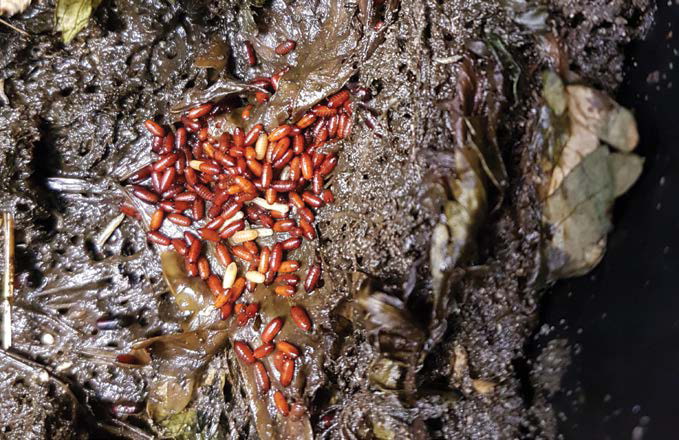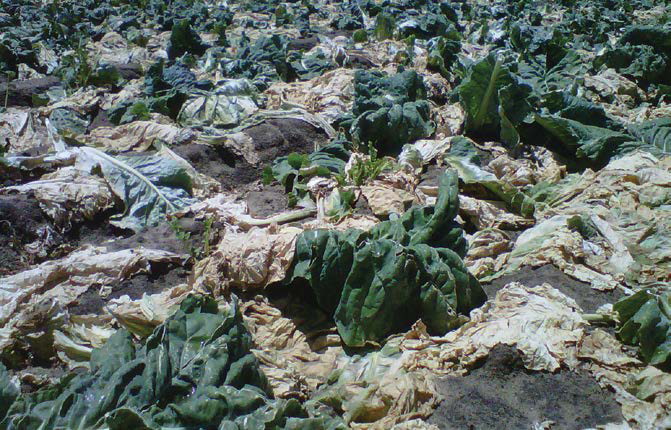Perfect season
to diminish stable fly breeding sites
BY KIM HAYWOOD
PROJECT OFFICER, DPIRD

PUPAE under reject cabbages.
Stable fly numbers are set to rise as the weather warms up, prompting a warning for horticulture growers, livestock owners and residents north and south of Perth to take action to minimise the impact of this declared pest. Stable flies are known for their painful bite to humans and animals — particularly pets, horses, and cattle.
The Department of Primary Industries and Regional Development (DPIRD) is supporting Local Government Authority inspectors to work with land owners and managers to remove stable fly breeding environments to reduce stable fly populations.
The Stable Fly Management Plan 2019 [agric.wa.gov.au/vegetables/stablefly-western-australia] was gazetted under the Biosecurity and Agriculture Management Act 2007 to provide guidance for commercial enterprises in the stable fly declared areas on how to effectively control stable fly.

AN adult stable fly (S. calcitrans) with prominent, biting mouthparts.
The stable fly problem has been escalating since the mid 1990s.
Under the Act, landholders are responsible for controlling declared pests on their land and penalties of up to $20,000 could apply if no controls are implemented by landowners.
The stable fly problem has been escalating since the mid 1990s, with the pest proving to be highly adaptable in almost any accumulation of decaying vegetable matter. The optimum larvae breeding environments have very high temperatures (55–60°C black sands, silage pits), a high degree of bacterial activity, ageing animal manures or combination of manure and vegetable matter. Therefore, managing larval habitats is the key to stable fly control.
The main stable fly breeding sources include vegetable crop residues left after harvesting, namely stalks, leaves and fruit left on the ground and harvested crop waste such as damaged and rejected produce.
Samples collected from commercial vegetable growers have shown that over 1,000 stable flies/m2can emerge from the soil of a trashed vegetable crop. Typically, one to several hundred stable flies develop from the rotting residue of broccoli, cabbage, cauliflower, celery, and lettuce crops. The sheer amount of vegetable matter on the ground represents a significant potential risk for stable fly breeding if it is left to rot for more than 3–4 days and/or is simply rotary hoed into the soil with minimal physical breakdown.
Breaking down vegetable crop residue into small pieces, will significantly reduce and even prevent stable fly breeding and have the added benefit of allowing growers to put another crop in that area sooner, which will reduce the risk of disease transmission to the next crop.
Reject produce must be either physically removed, put into an open pit, and buried weekly with at least 30cm of soil; or sprayed weekly with a high-volume pesticide application.
The vegetable crops that support stable fly development when residues of the crops are left to rot after harvest include: beetroot, broccoli, cabbage, cauliflower, celery, Chinese radish, coriander, corn, leek, lettuce, silver beet, spring onions and squashes.
Many vegetable and fruit crops that are regularly harvested over an extended period of time (weeks to months) result in rejected and/or damaged produce being left on the ground either under the crop vines or in the space between crop rows. This is often the case with crops such as eggplants (aubergines), rockmelons, watermelons, snow peas, sugar snap peas, paprikas (bell peppers), capsicums, carrots, and zucchinis.
Produce either rejected within the vegetable/fruit crop or at first stage processing and/or sorting are all capable of supporting the development of biting flies and other nuisance flies if not handled properly.
2019 Management Plan — Control measures
Stable fly larvae go through 3 larval instars; the smallest 1st instar larvae are just over 1mm when they first hatch from eggs. The 2nd instar stage occurs 2.5–4.5mm in length and the 3rd instar larvae range from 5mm up to 12–14mm long.
In determining the level of stable fly breeding on a property, it is important to gather the following information:
1 The size of the property
2 The proportion of the property where stable fly larvae/pupae are found
3 The density of stable fly larvae/pupae in that resource (number per sample or per square meter)
4 Is it an on-going problem or a one-off situation (machinery breakdown, manager away, weather conditions, accidental spillage, abandoned crop due to disease or market price fall, etc).
Managing larval habitats is the key to stable fly control.
Sampling techniques
When you have chosen an area to assess the level of stable fly breeding (i.e., presence of larvae and/or pupae), you must be as consistent as possible with what you decide is your sampling unit.
If it is the post-harvest remains of a vegetable crop, then select discrete pieces of the rotting material that are visible at the soil surface. Using a trowel helps to remove a consistent amount of vegetable matter and soil for inspection of fly larvae and/or pupae.


THE huge amount of leaves and stalks and reject produce left after harvesting is complete in crop such as silverbeet (above) and cabbage (left) provide a perfect breeding round for biting flies.
MORE INFORMATION
Online resources to assist landholders and animal owners to reduce the risk of stable flies, including control measures, surveillance advice and a factsheet, are available on the DPIRD website agric.wa.gov.au by searching for ‘stable fly’.
Primary producers and the general public are encouraged to report stable flies agitating horses and livestock or biting humans and pets via DPIRD’s MyPestGuide Reporter app or calling the Pest and Disease Information Service on (08) 9368 3080.